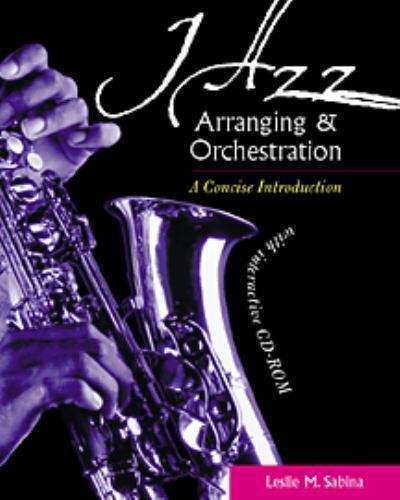Imagen 1 de 1

Foto genérica

Imagen 1 de 1

Foto genérica

Jazz Arranging and Orchestration : A Concise Introduction by Leslie M. Sabina (2001, Trade Paperback)
F
fracktone (313)
100% de votos positivos
Precio:
USD13,51
Aproximadamente11,59 EUR
+ USD23,39 de envío
Devoluciones:
30 días para devoluciones. El comprador paga el envío de la devolución..
Estado:
Jazz Arranging and Orchestration A Concise Introduction with Interactive CD-ROM.
Oops! Looks like we're having trouble connecting to our server.
Refresh your browser window to try again.
Acerca de este artículo
Product Identifiers
PublisherWadsworth
ISBN-100534585906
ISBN-139780534585907
eBay Product ID (ePID)1968948
Product Key Features
Number of Pages256 Pages
Publication NameJazz Arranging and Orchestration : a Concise Introduction
LanguageEnglish
SubjectGeneral, Instruction & Study / Techniques, Genres & Styles / Jazz
Publication Year2001
TypeTextbook
AuthorLeslie M. Sabina
Subject AreaMusic
FormatTrade Paperback
Dimensions
Item Weight20 Oz
Item Length11 in
Item Width7.9 in
Additional Product Features
Intended AudienceCollege Audience
Dewey Edition22
IllustratedYes
Dewey Decimal781.65/137
Table Of ContentPart One: Tools Of The Trade. 1. The Lead Sheet. Jazz Melody. Jazz Harmony. Jazz Rhythm. Syncopation. Jazz Phrasing and Articulation. Exercises. 2. The Jazz Band. Instrumental Characteristics, Transpositions, and Ranges. Saxophone. Trumpet. Trombone. Rhythm Section. Guitar. Piano. Bass. Drums. Auxiliary Percussion. Instrumental Combinations. Stylistic Characteristics. Swing. Fusion (Jazz-Rock; Funk). Latin (Bossa-Nova; Samba; Afro-Cuban; Salsa). Exercises. Part Two: Arranging. 3. General Voicing Techniques. Unison and Octave Voicings. Two-part Voicings. Three-part Voicings. Four-part and Five-part Voicings. Safe Low Limits. Exercises. 4. Sectional Voicing Techniques. Saxophone Section. Unison Voicings. Octave Voicings. Four-part, Doubled-lead Voicings. Five-part Voicings. Other Voicings (Two-part; Three-part; True Four-part). Trombone section. Unison Voicings. Octave Voicings. Four-part Voicings. Other Voicings (Two-part; Three-part). Five-part Voicings. Trumpet section. Unison Voicings. Octave Voicings. Four-part Voicings. Other Voicings (Two-part; Three-part). Five-part Voicings. Rhythm section. Unison Voicings. Octave Voicings. Other Voicings. Exercises. 5. Ensemble Voicing Techniques. Trumpets And Trombones. Unison and Octave Voicings. Sectional Four-part, Close-position (identical version) Voicings. Sectional Four-part, Close-position (differing version) Voicings. Sectional Four-part, Close-position/Semi-Open-position Voicings. Voicings with Upper-structure Triads. Other Voicings (Two-part/Four-part; Overlapping). Saxophones And Trombones. Unison and Octave Voicings. Exact Doubling. Saxophones above Trombones. Overlapping/Dovetailing. Trumpet and Saxophones. Unison and Octave Voicings. Trumpets above Saxophones. Overlapping/Dovetailing. Other Voicings (Two-part/Four-part). Complete Big Band. Unison and Octave Voicings. Sectional Four-part Voicings. Voicings with Upper-structure Triads. Other Voicings (Two-part/Four-part). Cluster. Exercises. 6. Approach Techniques. Parallel Approach. Diminished 7th-Chord Approach. Dominant 7th-Chord Approach. Tonicization. Exercises. Part Three: Formal Considerations In Arranging. 7. Formal Units. Fundamental Formal Units. Head Statement. Solo Section(s). Shout Section (Arranger's Chorus). Out Statement. Embellishing Formal Units. Introduction. Interlude. Send-Off. Ending (Coda). Exercises. 8. Formal Planning. Possible Arrangement Plans. Head, Solos, Shout, Out. Introduction, Head, Solos, Shout, Out, Ending. Introduction, Head, Shout 1, Solos, Interlude, Shout 2, Out, Ending. Introduction, Head, Interlude 1, Solos, Shout 1, Interlude 2, Solos, Shout 2, Out, Ending. Introduction, Shout 1, Interlude 1, Head, Solos, Shout 2, Solos, Interlude 2, Shout 3, Out, Ending. Possible Unit Plans. Through-composition. Exercises. Part Four: Compositional Elements In Arranging. 9. Variation. Melodic Variation. Identifying Characteristic. Embellished Jazz Melody. Melodic Rhythm. Harmonic Variation. Modulation. Embellished Jazz Harmony. Reharmonization. Harmonic Rhythm. Rhythmic Variation. Change of Tempo. Change of Meter. Exercises. 10. Background Material. Melodic Composition. Countermelody. Pads. Riffs. Harmonic Composition. Punches. Pads. Riffs. Rhythmic Composition. Exercises. 11. Composing For Formal Units. Fundamental Unit Composition. Head and Out Statements. Shout Section (arranger's chorus). Solo Section. Embellishing Unit Composition. Introduction. Interlude. Send-off. Ending. Exercises. Conclusion: COMPLETE ARRANGEMENTS FOR ANALYSIS. Four. Softly, As In A Morning Sunrise. There Will Never Be Another You. Glossary. Bibliography. Discography.
SynopsisWorking on the premise that students learn by doing, Sabina takes students step-by-step through the basics of arranging for the big band. Over 200 music examples support the theory presented in this text, and over 60 of the most valuable examples also appear on a dynamic, interactive CD-ROM that is shrink-wrapped with every new copy of the book. Music examples appear in two formats with synthesizer sound: locked Finale files (for analysis) and unlocked Standard MIDI Format files that allow students to experiment with sound and technique as they change the musical examples. Using the MIDI files, students can manipulate, print, and save their arrangements. The text and CD-ROM also include three complete arrangements that span from swing to jazz-rock. Back matter includes a comprehensive glossary, bibliography, and discography., Working on the premise that readers learn by doing, Sabina takes readers step-by-step through the basics of arranging for the big band. Over 200 music examples support the theory presented in this text, and over 60 of the most valuable examples also appear on a dynamic, interactive CD-ROM that is shrink-wrapped with every new copy of the book. Music examples appear in two formats with synthesizer sound: locked Finale files (for analysis) and unlocked Standard MIDI Format files that allow readers to experiment with sound and technique as they change the musical examples. Using the MIDI files, readers can manipulate, print, and save their arrangements. The text and CD-ROM also include three complete arrangements that span from swing to jazz-rock. Back matter includes a comprehensive glossary, bibliography, and discography.
LC Classification NumberMT73.5




